September 18, 2015
Air Date: September 18, 2015
FULL SHOW
SEGMENTS

Climate Protestors Take on Public Land Leasing
View the page for this story
A labor-green-faith-native rights coalition of 400 groups is demanding President Obama end fossil fuel leasing on public lands as part of a new climate activism campaign. Rainforest Action Network's Ruth Breech tells host Steve Curwood,cutting off the extraction of fossil fuels from public lands would be the single greatest action that President Obama could take to tackle greenhouse gas emissions and take on climate change. (05:30)

EPA Broke the Law When it Approved a Pesticide Unsafe for Bees
View the page for this story
The EPA failed to follow its own rules for ensuring chemical safety and thus illegally approved a powerful insecticide linked to declining numbers of honeybees, a Federal Appeals Court has ruled. Earthjustice staff attorney Greg Loarie speaks with host Steve Curwood about the case involving sulfaxoflor. (07:30)
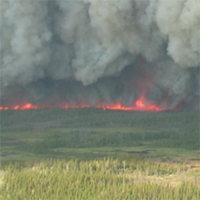
Fires Threaten the North
View the page for this story
This summer’s wildfire season has been one of the most intense in North America’s recorded history, especially in the West and Far North. Not only have whole neighborhoods been wiped out, but, the warming climate and increased fires are also changing the composition of the tundra ecosystem. Scientist Scott Goetz of the Woods Hole Research Center talks with host Steve Curwood about the new north, and how the migration of trees northward is leading to more climatic disruption. (07:30)
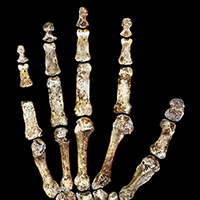
Scientists Say They've Discovered A New Species of Humans
/ Bobby BascombView the page for this story
Two years ago, paleoanthropologists climbed deep into South Africa’s Rising Star Cave system and found hundreds of skeletons of what scientists now believe is a new hominin species, called Homo naledi. Living on Earth’s Bobby Bascomb follows one of the spelunking scientists down into the cave’s entrance and hears about the fortuitous find by some of the excavation’s lead researchers, as well as the question of whether or not this species deliberately buried its dead. (06:50)

Beyond the Headlines
/ Peter DykstraView the page for this story
In this week’s trip beyond the headlines, Peter Dykstra tells host Steve Curwood about the ousting of Australia’s climate-denying Prime Minister and some changes in the U.S. media -- both of which could influence the conversations on environment and climate change -- and celebrates Captain Planet’s twenty-five years of saving the world, one television viewer at a time. (04:50)

The Night Bird
/ Michael SteinView the page for this story
Most songbirds sing during the daylight hours, but it’s the Eastern Whip-poor-will that comes alive as the sun sets. BirdNote’s Michael Stein reads Henry David Thoreau’s account of the lovely nightjar bird’s song and notes how habitat loss is causing the population’s decline. (02:00)
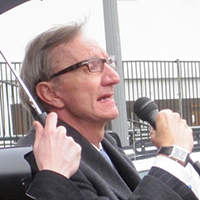
An Evangelical View of the Climate and Pope Francis
View the page for this story
As he reflects on the relevance of Pope Francis’s environmental encyclical to evangelicals, Rev. Richard Cizik tells host Steve Curwood why he’s hopeful that his community is undergoing what the Holy Father calls an “ecological conversion”. (12:05)
Show Credits and Funders
Show Transcript
HOST: Steve Curwood
GUESTS: Ruth Breech, Greg Loarie, Richard Cizik
REPORTERS: Bobby Bascomb, Peter Dykstra, Michael Stein
CURWOOD: A new front in the fight against global warming – green groups, Native Americans and labor join together to demand the US President stop granting leases to extract coal or oil on federal lands.
BREECH: This is just the beginning. We have to address the climate crisis and for President Obama to stop fossil fuel leasing on public lands would be the way to establish his climate legacy.
CURWOOD: Also, the enticing ad that found the tiny cavers who unearthed the latest branch on our family tree.
BERGER: I just basically said that you needed to be skinny, not claustrophobic and you had to be able to drop everything within three weeks and come for an undetermined amount of time to South Africa - unpaid. Oh, and you had to have a PhD or masters in paleo-anthropology, archeology or a related field.
We’ll have those stories and more this week, on Living on Earth. Stick Around.
ANNOUNCER: Support for Living on Earth comes from United Technologies – innovating to make the world a better, more sustainable, place to live.
Climate Protestors Take on Public Land Leasing
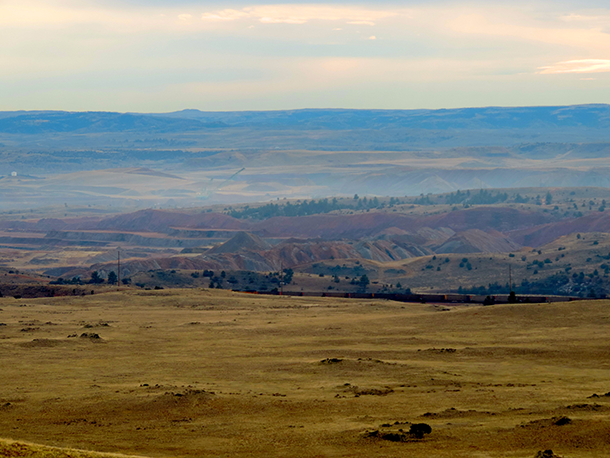
The Powder River Basin in Wyoming has massive coal deposits. (Photo: Wildearth Guardians, CC BY-SA 2.0)
CURWOOD: From the Jennifer and Ted Stanley Studios at the University of Massachusetts Boston and PRI, this is Living on Earth. I’m Steve Curwood. Science now tells us that if all the known fossil fuel left on Earth were burned, it would raise sea levels as much as 160 feet as ice melted, so activists are now demanding that it stay in the ground. And on September 15th a coalition of some 400 groups converged on the White House to call on the President to stop leasing federal lands and the coastal seabed for the extraction of coal and petroleum. They are taking on a big business: for example, in recent times some 400 million tons of coal a year have been mined from federal lands, much of that for export. We called up Ruth Breech, a senior campaigner with RainForest Action Network, as she came back from the demonstration at the White House. Welcome to Living on Earth.
BREECH: Great, thanks for having me.
CURWOOD: So what is your basic message here?
BREECH: We're telling President Obama...we're asking him if he really wants to leave a climate legacy and address the crisis that is in front of us right now, then he needs to stop leasing federal fossil fuels - coal, oil and gas - and keep our carbon reserves in the ground.
CURWOOD: How much global warming is related to the extraction of fossil fuels from public lands in the US, including offshore federal territory?
BREECH: Right. When Obama…when the Obama administration decides to stop federal fossil fuel leasing, we can keep up to 450 billion tons of greenhouse gas emissions in the ground. Compare this to Obama's recent announcement with the clean power plan initiatives -- so this is the emissions reductions coming out of power plants -- and that's only six billion tons of emissions and this is 450 billion -- so on orders of magnitude this is much larger. So this is a big bold act and it's critical.
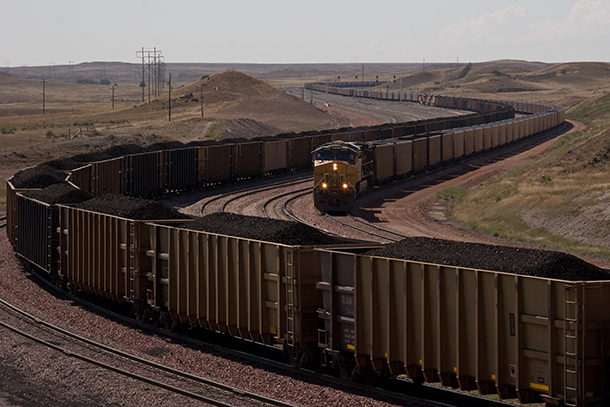
Much of the coal from the Powder River Basin is getting exported through coal terminals in the Pacific Northwest. (Photo: Kimon Berlin, Flickr CC BY-SA 2.0)
CURWOOD: Now, of course there's federal land in every state, but what parts of America most contribute to fossil fuel production from public lands?
BREECH: Most of the contributions to fossil fuel production is coming from the west, so this would be Montana and Wyoming -- there's a region there called the Power River Basin; northern New Mexico and Arizona and the Navajo nation. A lot of the public lands are adjacent to, if not within the boundaries of, Native American reservations. We're also looking at offshore areas, so this would be the Gulf coast, the Arctic, the Atlantic. These are hotspots that industry wants to mine, drill or frack.
CURWOOD: How much power does President Obama have to halt the leasing of fossil fuel extraction on federal lands if he decides he wants to?
BREECH: He has all the power. The Center for Biological Diversity just issued a report last week and outlined his legal authority to issue an executive order to stop the program today. He could also too if he didn’t want to be that active, he could just decide to not approve things, he could have not approved, it could have just sat on his desk for the next 18 months, Arctic drilling; he could have not approved the Atlantic leases that will be coming up the next few months. He could just leave them alone and leave them on his desk.
CURWOOD: Sally Jewell is the Secretary of the Interior, and that's the organization that actually conducts leasing for energy extraction from public lands for the very most part, and she's been quoted saying that the President certainly is mindful of global warming, but that we need these fossil fuels to run our economy right now. Your reaction?

A significant portion of oil drilling on US public lands is happening offshore. (Photo: Maersk Drilling, CC BY-NC-ND 2.0)
BREECH: I think it's shortsighted. What you hear from Sally Jewell and other administrative officials in that capacity is that they somehow think that their mission is to balance industry's interest with that of the planet, and if you really think about it is like short-term profit versus long-term sustainability. So I really would like to see her looking longer-term. What does this look like in 10 years, 20 years? Because fossil fuels are eventually going to go away. Coal is already dying. The gas boom is not as big as we originally thought. This is their opportunity to really get ahead of this. What is their plan? How are we going to use our lands appropriately? How are we going to use our resources, and how are we going to address this climate change crisis that we have on our hands right now?
CURWOOD: Ruth, how much presidential politics is in this? The Democratic candidates are out in front of President Obama on the subject already. Hillary Clinton has already called for a halt on offshore drilling in the Arctic, and I can only guess that Bernie Sanders would be even more sympathetic to your call.
BREECH: Right, we'd love to see that. Ideally this would happen within this presidency, I think Obama has the power and the timing is ripe right now. Folks are already reaching out to candidates to get their views on it, I love that Hillary came out against Arctic drilling. I think that was bold. So I think if the candidates are smart then they're going to address this in their debates. They are going to address this in their platforms, and they're going to make a decision about it, and they are going to have a plan coming into office if this issue has not already been addressed.
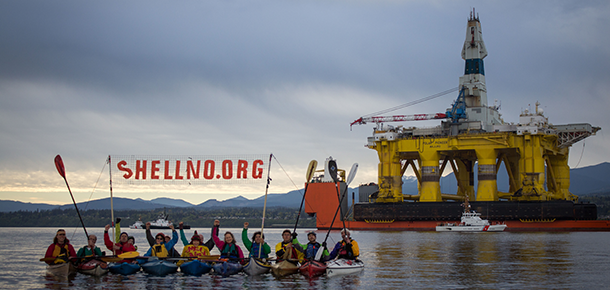
“Kayaktivists” protest the government’s decision to allow oil drilling by Shell in the arctic. (Photo: Backbone Campaign, CC BY 2.0)
CURWOOD: Ruth, what happens next?
BREECH: This is the next bold ask coming from the climate movement. We're seeing unprecedented unity in the coalition. We've got big greens -- frontline organizations, climate justice groups working alongside labor unions, faith groups all coming together and showing how much power there is in the grassroots. This is just the beginning. We have to address the climate crisis, and for President Obama to stop fossil fuel leasing on public lands would be the way to establish his climate legacy. It would move us at a whole other level of magnitude in addressing these issues.
CURWOOD: Ruth Breech is a Senior Campaigner with the Rainforest Action Network. Thanks so much for taking the time with us today, Ruth.
BREECH: Thank you.
Related link:
Keep It In The Ground campaign
EPA Broke the Law When it Approved a Pesticide Unsafe for Bees
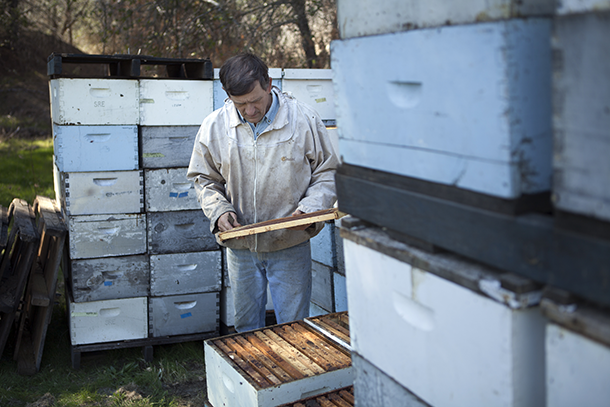
Minnesota beekeeper Steve Ellis stands in front of once bee-filled boxes that were left empty after being hit by colony collapse disorder. (Photo: Chris Jordan-Bloch/Earthjustice)
CURWOOD: Federal courts hardly ever overturn agency rules, but the Ninth Circuit Court of appeals has found that the EPA illegally approved an insecticide linked to declining numbers of honeybees. The court found the EPA had failed to get enough evidence from the maker, Dow AgroSciences, to approve the safety of Sulfoxaflor. Sulfoxaflor is a neonicotinoid, a systemic insecticide that becomes part of all of a plant’s tissues and is poisonous for insects. Commercial beekeepers and the environmental group EarthJustice sued the EPA about the approval of Sulfoxaflor. Greg Loarie is the staff attorney with EarthJustice, who argued the case.
LOARIE: In the case of Sulfoxaflor what the court found is that EPA approved Sulfoxaflor without any reliable information about the risk that it would present to honeybee colonies. And that, of course, is a huge shortcoming when we're in the midst of this crisis where we are losing over one-third of our honeybee colonies every year, and science is pointing to these sorts of insecticides as a primary cause.
CURWOOD: Now, it's practically unheard of for a court to overturn an Environmental Protection Agency chemical registration. What happened in this case?
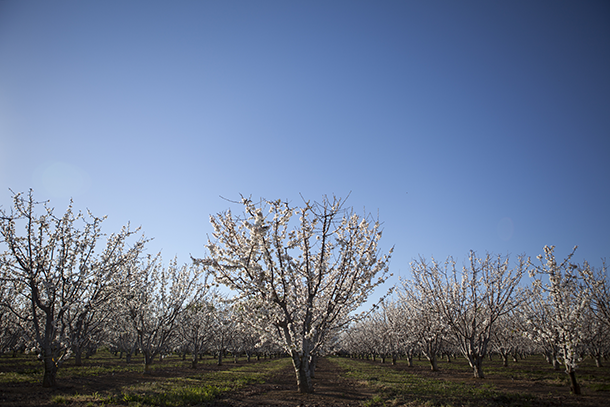
Cherry trees in bloom near Stockton, CA. (Photo: Chris Jordan-Bloch/Earthjustice)
LOARIE: Well, the case began shortly after EPA approved Sulfoxaflor in the summer of 2013. EarthJustice was approached by America's commercial beekeeping industry, the biggest trade groups in America, including the American Honey Producers Association, American Beekeepers Federation and others. And these folks are really at their wits’ end. They are at the point where beekeepers are going out of business. They approached EarthJustice and said, “is there anything we can do about this latest neonicotinoid coming onto the market?” And we took a look at the registration and found that indeed EPA had not met its own guidelines, didn't have the information it that was supposed have in hand, and so we filed suit. Under the law the case bypasses the lower courts, goes straight to the court of appeals and the case was heard last April. And then finally we get the decision concluding that indeed EPA had broken federal law when it approved Sulfoxaflor. And it is quite unusual for courts to overturn pesticide registrations and partly that's because the law gives EPA a great deal of authority and courts give EPA a great deal of deference because it's a matter that does involve a fair amount of scientific expertise, it's very technical and the courts don't feel like they're in a position to second-guess that sort of science. But in the case of Sulfoxaflor the science was so lacking and it was so clear that EPA just didn't have this fundamental information that the court found that the registration had to be overturned unless and until that information is brought to bear.
CURWOOD: What conditions does a chemical, this insecticide, have to meet in order to be approved by the EPA and how is that determined?
LOARIE: Under federal law, EPA's job is to ensure that use of a pesticide will not cause an unreasonable environmental or human risk. They take in a great deal of information from the company that is marketing the pesticide and they try to determine whether it's going to present a risk to the environment, and, if so, how do we mitigate that risk -- for instance, by putting restrictions on the label, time that you can spray it, amount you can spray, that sort of thing. But at the end of the day, it's something of an imprecise process and it also of course relies on the quality of the information that's coming in.
CURWOOD: Describe for me what EPA did or didn't do in connection with approving this chemical Sulfoxaflor.
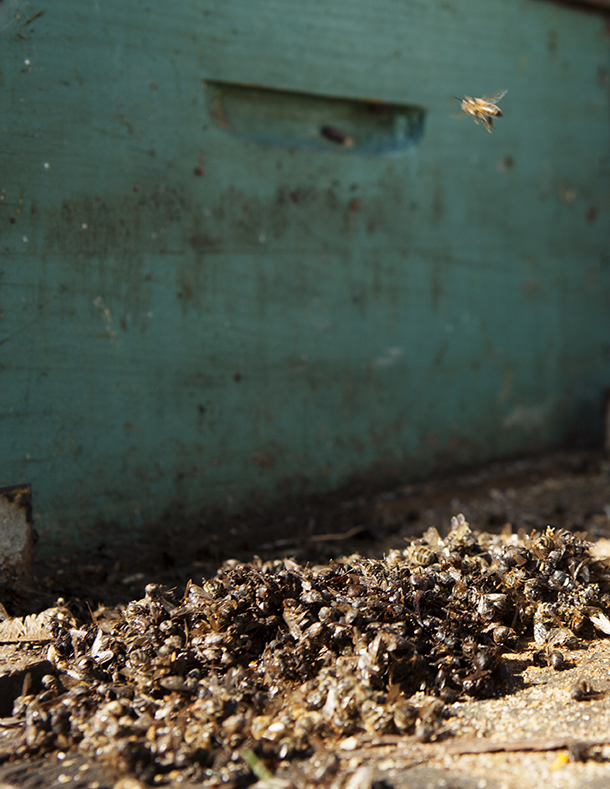
A solitary bee flies above dead bees in bee boxes in Calaveras County, California. The boxes were once filled with thousands of bees but colony collapse hit the boxes and only a few bees remained. (Photo: Chris Jordan-Bloch/Earthjustice)
LOARIE: Sure. To determine the impact that a insecticide will have on what they call non-target insects like honeybees, traditionally EPA has studied what it calls the acute toxicity of a pesticide and essentially what that means is they take a honeybee into the laboratory, they expose that individual adult honeybee to the pesticide, and they figure out how much of the pesticide does it take to kill that adult honeybee. And they figure that, well, if bees will be exposed to less than that lethal dose, then that pesticide won't cause any problems. Now, this whole process really falls to pieces when you have the systemic insecticide overlay. It may not kill on contact, the adult bee might go out into the field, collect pollen that has the Sulfoxaflor or the systemic insecticide in it. And so the adult bee brings the pollen back into the hive, feeds it to the developing brood and over time that build up within the hive causes the whole colony to sicken, weaken and ultimately collapse. So what the law says is EPA needs to consider this possibility. EPA needs to do not only those laboratory studies but also EPA has to consider what happens when we put a hive out in the real world and put it in a situation where it is feeding on crops that have been sprayed with the systemic insecticide, and that's the information EPA so desperately needs and the information that it certainly lacked in the case of Sulfoxaflor.

Alyssa Anderson, daughter of Jeff Anderson, the beekeeper in California, lights a bee hive smoker as part of her work as a beekeeper. (Photo: Chris Jordan-Bloch/Earthjustice)
CURWOOD: Now, typically when it comes to registering a chemical with the EPA, the manufacture of the chemical does all that research. In this case why do you think Dow didn't conduct this research before they submitted their paperwork to the EPA?
LOARIE: You're absolutely right. The way the law is set up, the studies are all conducted by the corporation that is seeking registration and then EPA's role is simply to review that information. Dow did submit six studies. What EPA found however is that all six of the studies had numerous scientific flaws and were inherently unreliable, so, for instance, most of them studied a exposure to Sulfoxaflor that was well below what would actually be happening in the field, several of them lacked control groups of any kind. And, yet, at the end of the day, EPA decision-makers decided to register Sulfoxaflor, notwithstanding the flaws inherent in the studies.
CURWOOD: So what happens next for Sulfoxaflor?
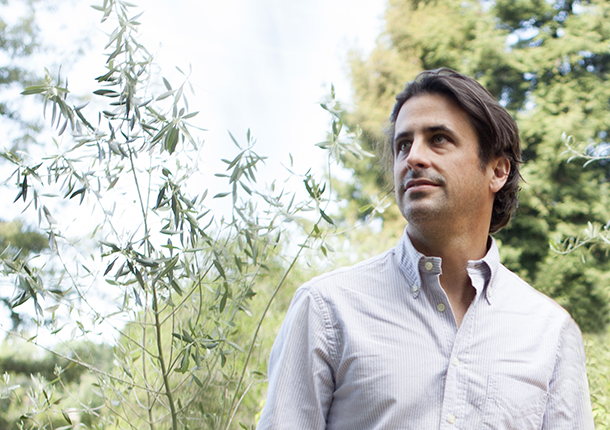
Greg Loarie. (Photo: Chris Jordan-Bloch/Earthjustice)
LOARIE: Well, the court set aside EPA's decision to register Sulfoxaflor. So the effect of the court’s ruling is that Sulfoxaflor goes off the market unless and until Dow submits to EPA this information and EPA goes through this process again all the while this time around. So our hope is that this decision catalyzes EPA to really move much more quickly to protect what ultimately are not just honeybees and not just commercial beekeepers, but all of us and the nutritional diet that we require.
CURWOOD: Greg Loarie is a Staff Attorney with EarthJustice. Thank you so much for taking the time today, Greg.
LOARIE: Thank you.
Related links:
- Case: Pollinator Stewardship Council v. EPA
- Listen to a recording of the case
- Dow AgroSciences Receives U.S. EPA Registration for Sulfoxaflor
- Sulfoxaflor and the sulfoximine insecticides: Chemistry, mode of action and basis for efficacy on resistant insects
- More about Dow’s Product Safety Assessment of sulfoxaflor
- Dow AgroSciences Statement on Ninth Circuit Ruling Regarding Sulfoxaflor
- An Earthjustice Photo Essay: “The Perfect Crime: What’s Killing All the Bees?”
- Earthjustice’s “Federal Court Overturns EPA Approval of Bee-Killing Pesticide”
- Federal Insecticide, Fungicide, and Rodenticide Act (FIFRA) provides federal control of pesticide distribution, sale, and use.
CURWOOD: We asked both Dow Agrosciences and the EPA for comment.
The EPA said in part, “We are reviewing the opinion in consultation with the Department of Justice to determine our next steps.” Dow Agrosciences “respectfully disagrees with the Ninth Circuit’s conclusion”. Their responses are posted in full at our website, LOE.org.
[MUSIC: Jerry Garcia and David Grisman, There Ain’t No Bugs on Me, Not For Kids Only, Acoustic Disc, 1993]
-----
EPA’s Statement in full:
“We are reviewing the opinion in consultation with the Department of Justice to determine our next steps. The Court’s decision won’t take effect until it issues its mandate, which will not happen for at least 45 days.”
Fires Threaten the North
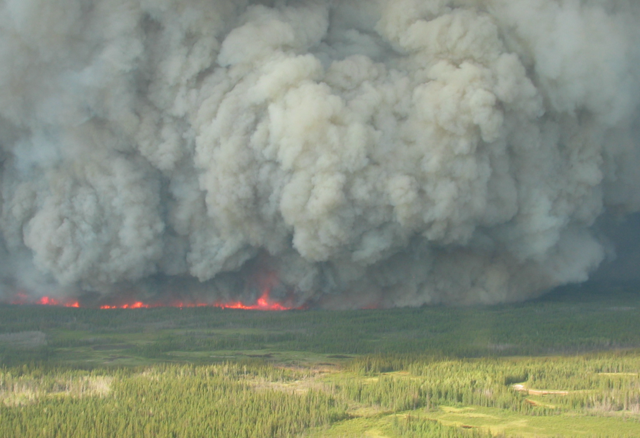
A boreal forest fire. (Photo: Dennis Quintilio)
CURWOOD: The end of summer in the US has seen unprecedented and catastrophic wildfires in the Pacific Northwest, with whole neighborhoods burned to the ground in California. But the fire season up in Alaska and elsewhere in the far north was also devastating, and the eight million or more acres burned there raises some ominous questions about the future of permafrost and boreal forests. To find out why we are seeing so many fires, especially in the cold north, we turned to Scott Goetz, a senior scientist with the Wood’s Hole Research Center.
GOETZ: A lot of it is related to climate change, warmer, drier air masses that set the conditions for very intense fires, and some of the unique aspects especially of fire in Alaska this year was just how intense they were for a period of time right at the peak of summer in July. And that's a very important factor in determining how the forests change in the future, the severity of the fires that take place.
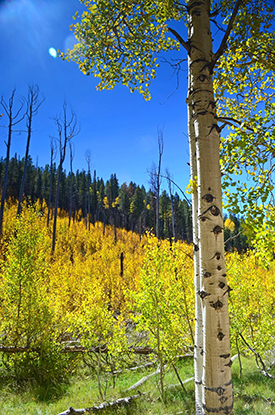
Boreal forest. (Photo: Cynthia McWilliams)
CURWOOD: Now, President Obama was recently in Alaska talking about the importance of climate change. How are the forest and the Arctic changing with climate change?
GOETZ: They’re changing in a number of ways and by Arctic we would include boreal forest which is the belt of northern forests that cross Alaska, Canada and Russia. And those are changing largely as a result of fire, again, linked with changes in climate and these hot air masses, and that also influences the productivity of the forests. In other words, they don't grow as well during these very hot summers and we call that ‘browning’ -- what we observe in satellite images, for instance, we call ‘browning’, in another words, declining productivity trends, and we've mapped that over these northern forests.
CURWOOD: I'm looking at an article that recently ran in Science Magazine, that is quoting you, among others, and you have this map, this image of the browning of the boreal belt. What are the areas that are most at risk that you see with these observations? It looks like there's a lot in North America.
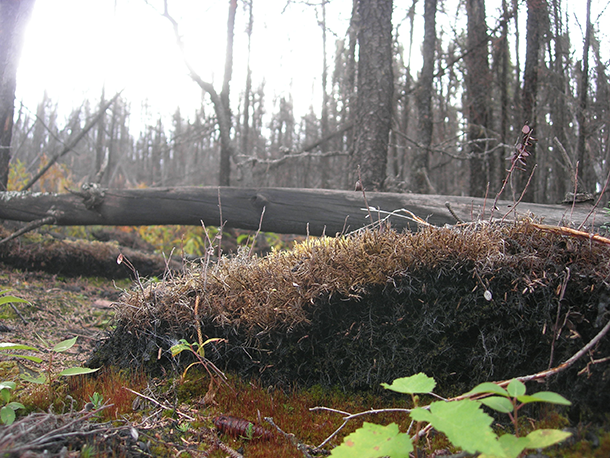
Burned peat after an arctic forest fire. (Photo: Brendan Rogers, Woods Hole Research Center)
GOETZ: There's a lot in North America. That's right, there's a belt across interior Alaska, the central part of Alaska, and across especially the southern range of boreal forest in Canada. So that's quite a large area; it's not everywhere that’s browning, and in the higher Arctic we actually see a lot of greening taking place increases in, say, shrub growth and tundra vegetation growth.
CURWOOD: So if there's new patches of green and new patches of brown, it sounds like trees might be moving. How correct is that?
GOETZ: There is pretty good evidence for movement of trees in these northern forests. There's a lot of interest in keeping track of that because it has large implications for climate, in terms of feedbacks to climate from changes in the surface energy balance related to the density of trees or shrubs. In other words, as trees migrate north, they're much darker than the other vegetation there, and they absorb a lot more solar energy, and they retain that energy, so it warms the surface. And there're also pretty good estimates of what it's likely to look like in 30, 40, 50 years from now from fairly conservative models of just the habitat suitability for trees.
CURWOOD: And what do those models show you?
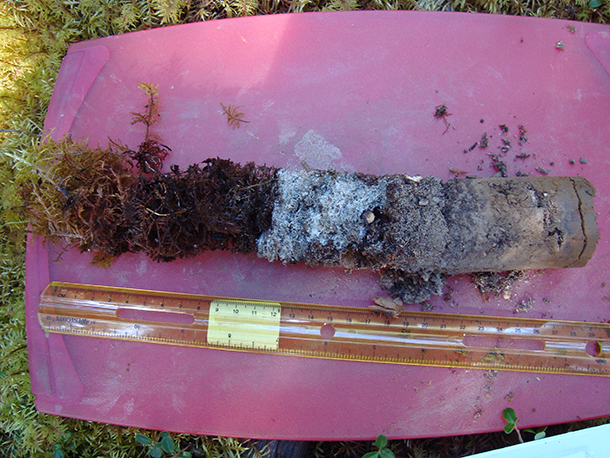
Soil core from the tundra. (Photo: Brendan Rogers, Woods Hole Research Center)
GOETZ: They show quite a lot of change, in terms of trees migrating northward from their current range into tundra vegetation, what is currently tundra vegetation.
CURWOOD: So, how much of this is good news, how much is bad news? Trees, of course, take up carbon dioxide from the atmosphere -- so more trees might be a good thing? Or, not in this case?
GOETZ: It depends where. In the tropics it's almost certainly true that more trees are a good thing because they take a tremendous amount of carbon out of the atmosphere and regulate the climate system. In northern regions, the presence of trees, they remove some carbon from the atmosphere but they're not highly productive systems. So what really matters there is how they change the energy balance and they absorb a lot of sunlight, retain that heat, and that can change climate. In fact, some of our work shows that that factor of changing the energy balance far outweighs increases in plant biomass as a result of warming climate.
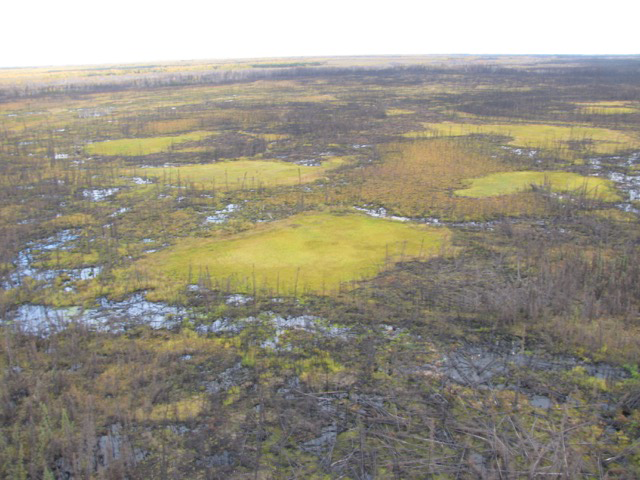
Melted permafrost after a wildfire. (Photo: Sue Natali)
CURWOOD: Now, how are the fires transforming the soil as well as the forest ecosystem in the north?
GOETZ: Fire in these northern systems actually burns off soil, especially in years like we saw this year, with very intense fires. The soil actually burns, and that has a lot of implications because it changes what comes back after fire. In North America, we often see that producing a shift from what is currently an evergreen conifer forest to a deciduous forest that persists for decades. And that, again, changes the energy balance, it changes the amount of water that they transpire to the atmosphere and it changes nitrogen nutrient cycling and changes the whole productivity of the system, and that, again, persists for decades. So those are big changes, it sets the system on an entirely new course.
CURWOOD: Scott, talk to me about the permafrost in the northern forests and what's happening with that in the face of these fires?
GOETZ: Permafrost contains a tremendous amount of carbon, almost twice the carbon or more than twice the carbon that is currently in the atmosphere. So there's a lot of concern about permafrost degradation and release of carbon into the atmosphere as a result of warming. And fire has great potential to degrade permafrost much more rapidly because it's burning off the insulating layer of soil and peat that insulates the permafrost, these frozen ground areas, from the atmosphere.
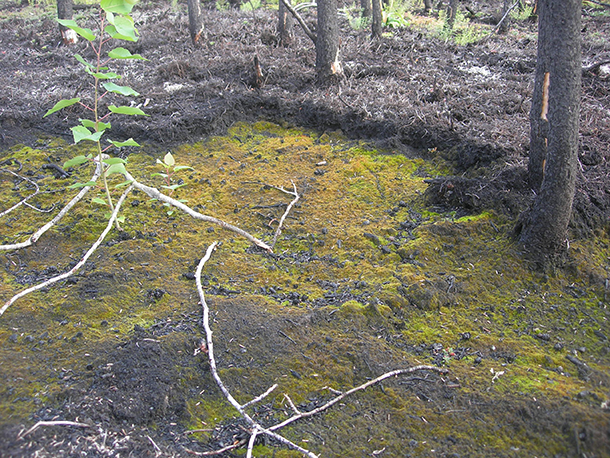
Permafrost melting can lead to subsidence. (Photo: Torre Jorgensen)
CURWOOD: Scott, how can this process and the high Arctic's record number of fires of the degradation to the permafrost, how can this be halted or reversed?
GOETZ: I think it's largely a matter of bringing awareness to the issue to help policymakers understand tremendous potential for carbon emissions from permafrost, especially permafrost combined with severe fires, to produce enough emissions to the atmosphere that it’s equivalent to another United States in terms of total emissions from fossil fuels. So I think that needs to get on the radar screen of the policymakers and enter the discussions of how to mitigate additional climate change and to cut fossil fuel emissions.
CURWOOD: Scott Goetz is a Senior Scientist and Deputy Director at the Woods Hole Research Center in Massachusetts. Thanks so much for taking the time with us today.
GOETZ: Thank you for having me.
Related link:
The New North
Scientists Say They've Discovered A New Species of Humans
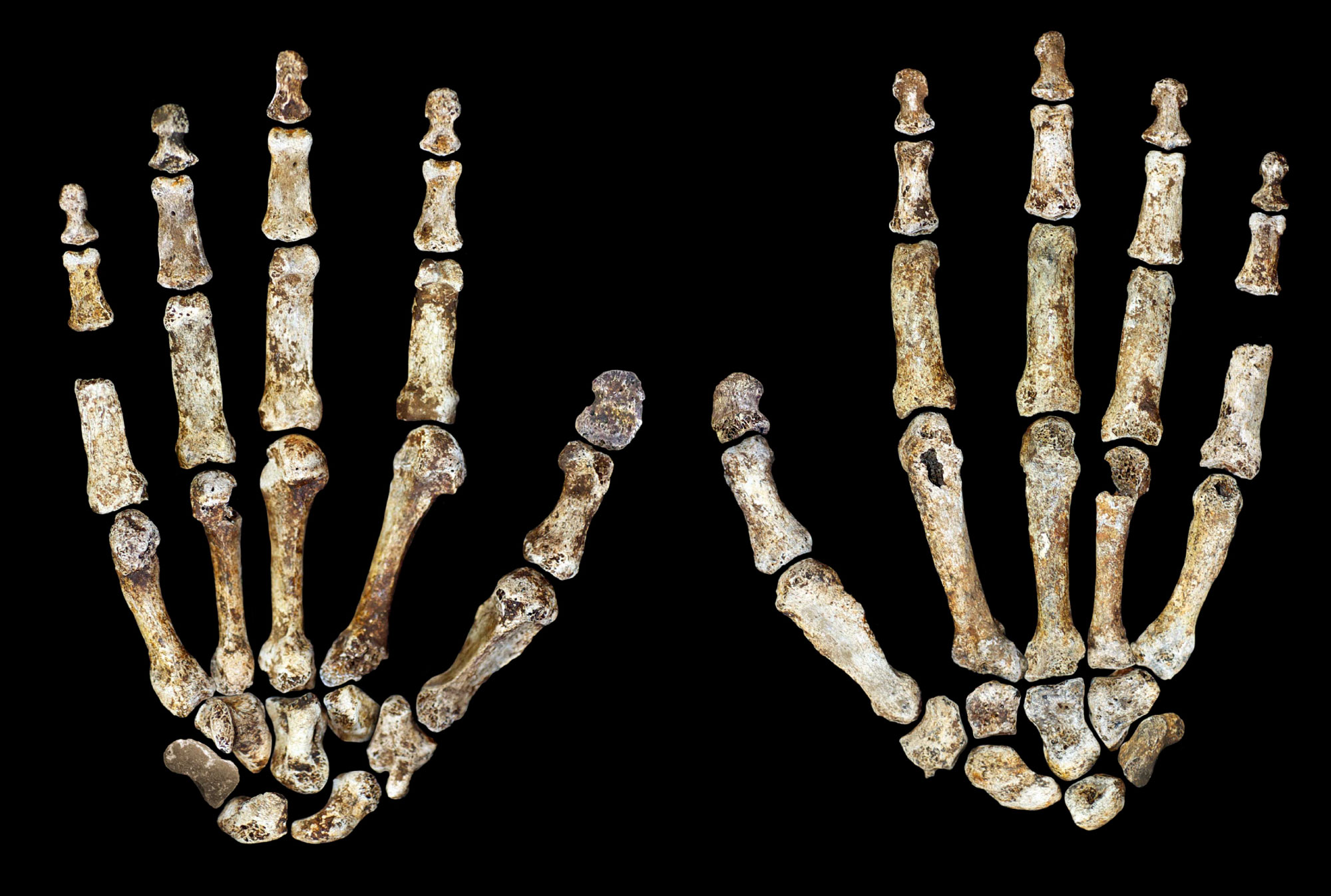
Homo naledi’s hands were curved more than modern humans’, indicating that they were good climbers. (Photo: Peter Schmid, CC BY)
CURWOOD: Now, there are many different species of nearly every type of animal living on earth today. Dozens of whale species, thousands of butterflies and frogs; yet there is only one type of living human. Of course, that wasn’t always the case. Once, there were several other members of the genus Homo -- Homo Erectus, Homo Habilis and Homo Neanderthalensis, for example. And now, paleo-anthropologists think they have discovered a new member of our genus deep in a cave in a part of South Africa aptly named the Cradle of Human Kind. Living on Earth’s Bobby Bascomb went to check out the site.
[WALKING SOUNDS]
BASCOMB: It’s a cool overcast morning about an hour northwest of Johannesburg, South Africa. Post-doc researcher Marina Elliot leads the way past horses in a farmer’s field towards a small stand of trees.
ELLIOT: So just watch your head here, that’s quite low.
BASCOMB: She scrambles down a rocky path and emerges into a large cave. It doesn’t look like anything special -- hundreds of caves just like this dot the landscape here.
ELLIOT: You would really never know that this was something earth-shattering, but it definitely is.
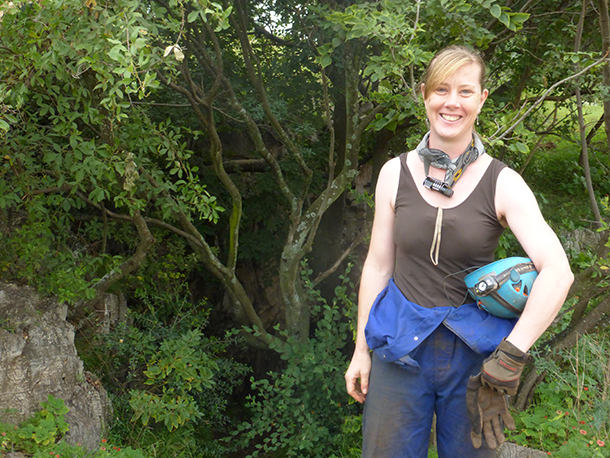
Marina Elliot. (Photo: Bobby Bascomb)
BASCOMB: The cave system is called Rising Star, and deep inside, researchers have discovered thousands of bones belonging to what appears to be a new species in our genus, Homo -- they’ve named it Homo naledi -- naledi means a star in the local Sotho language.
HAWKS: If you’re an anthropologist this is as good as it gets.
BASCOMB: John Hawks is an anthropology professor at the University of Wisconsin and one of the lead researchers for the excavation. He says the sheer number of fossils found here is unprecedented - over the course of 21 days the team unearthed more than 1500 individual bone fragments, more than had been found in the previous 90 years of exploration in Southern Africa. Hawks says they’ll be able to learn a lot about human evolution from the Homo naledi fossils.
HAWKS: We don’t really know how our ancestors developed before they were human; the reason is we just haven’t had fossils that represent the whole life span.
BASCOMB: But the Homo naledi find will change that. Scientists unearthed bones to represent nearly every part of the skeleton for every age group - infants to elders. What they found is a creature that’s strikingly similar to modern humans in some ways but extremely primitive in others. The brain was roughly a third the size of modern humans - the shoulders, chest, and pelvis were also very primitive. The hand was similar to ours but curved, an adaptation for climbing trees. But Lee Berger, the lead author of the study, says the feet of Homo naledi are extremely modern.
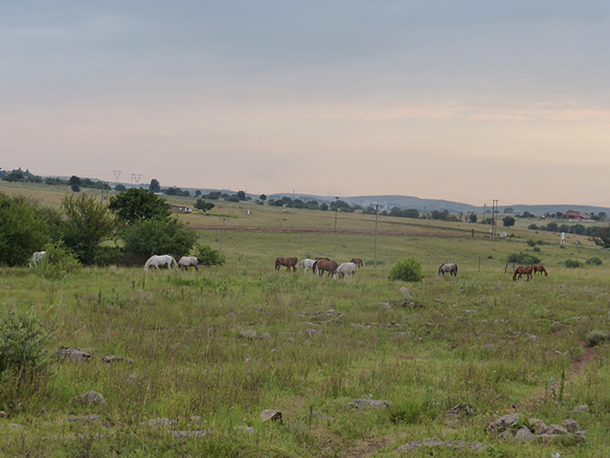
The field you walk through to reach the caves. (Photo: Bobby Bascomb)
BERGER: The feet are practically indistinguishable from a human’s. This is a walker.
BASCOMB: Berger is a research professor at the University of Witwatersrand and a National Geographic explorer in residence. While he was working on a hominin species called Australopithecus sediba, that he discovered just a few miles from the naledi bones, Berger commissioned local spelunkers to go out looking for more hominin fossils. On October 1st, at 9:00 at night they came knocking on his door and showed him photographs of a mandible and skull resting in loose soil - an unheard of find.
BERGER: To see these things lying on the surface with early hominin morphology was just staggering.
BASCOMB: Berger was so excited about the find and worried about its security that he couldn’t sleep that night. So at 2:00 in the morning he called Terry Garcia, then the head of exploration at National Geographic.
BERGER: I said, “Terry, if you’re ever going to believe in me, believe in me now.” He waited for a moment and then he said, “do what you need to do.” Which is explorer speak for you can have money.
BASCOMB: Berger’s next challenge was to find qualified scientists who could retrieve the fossils. The tall, skinny, cavers that initially found the bones described a tight squeeze through a gap just 7.5 inches wide and later a narrow chute where they had to lie on their stomachs and push themselves forward with their toes.
BERGER: I didn’t know how I was going reach out to find very tiny people with these extraordinary skills to work in the cave. So I did what my generation does. I turned to social media. I wrote an ad. I didn't tell them what they were doing, I just basically said that you needed to be skinny, not claustrophobic, and you had to be able to drop everything within 3 weeks and come for an undetermined amount of time to South Africa -- unpaid. Oh, and you had to have a phd or masters in paleoanthropology or related field. I thought there were maybe 3 people in the world with that.
BASCOMB: In just over a week Berger had 57 applicants, 80% of whom were young women. The 6 scientists he ultimately chose to wriggle through the tiny space were all petite women. And it’s partly because the cavern is so inaccessible that Berger is confident in advancing his most bold and potentially controversial hypothesis about Homo naledi.
BERGER: We think that this species of non-human animal deliberately disposed of its dead in that chamber. It implies a lot of things, it implies they recognized their own mortality. They recognized other self. They took some level of risk to move into the deep dark zone of a chamber to make sure that their dead were not touched by the external environment, in perpetuity.
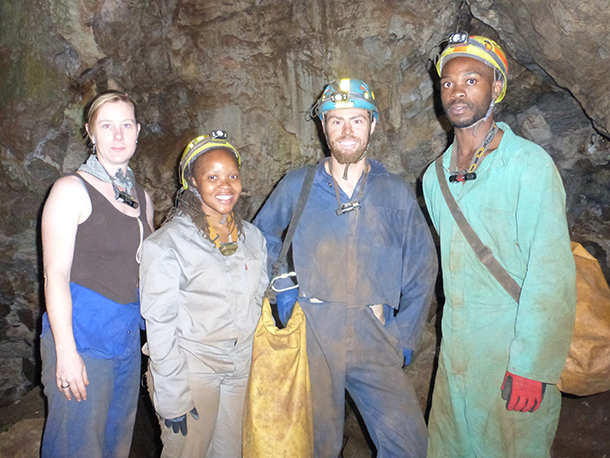
Marina Elliot (left) and Steven Tucker (third from left), the caver who actually found the fossils originally. (Photo: Bobby Bascomb)
BASCOMB: Modern humans are the only creatures known to purposefully bury their dead, a custom that scientists believe arose between 60,000 and 80,000 years ago. Not all of Berger’s peers are ready to accept his theory of purposeful burial. William Jungers is chair of anatomical sciences at Stony Brook University. He says it’s possible there was once another, easier to access, entrance to the cavern and cautions against arguing for more meaning behind the final resting place of these hominins.
JUNGERS: If you were frequenting this cave or living near by and had a deceased relative starting to decompose you might want to dispose of it in some dark deep hole yourself to get away from it.
BASCOMB: Researchers say they have literally just scratched the surface of the Rising Star cave system. In 3 weeks they excavated an area roughly a foot deep, three feet square and they estimate there are thousands of bones yet to be removed. So, whatever the age and importance of Homo naledi turns out to be, paleoanthropologists will have plenty of work for years to come.
For Living on Earth I’m Bobby Bascomb in Johannesburg, South Africa.
Related links:
- Study: Homo naledi, a new species of the genus Homo from the Dinaledi Chamber, South Africa
- AMA with two of the spelunking paleoanthropologists who found the bone fragments
- The Rising Star scientists answer questions about Homo naledi
- Watch a NOVA and National Geographic special about the South African discovery of hominin remains
- About Professor John Hawks
Beyond the Headlines

Captain Planet, the eco-super-hero who battled environmental villains with the help of his “Planeteers”, turns twenty-five this week. (Photo: courtesy of the Captain Planet Foundation)
CURWOOD: Well, not lurking in a cave is our guide to the world beyond the headlines. He’s Peter Dykstra of the DailyClimate.org and Environmental Health News, that’s EHN.org. He’s on the line from Conyers, Georgia. Hi, Peter.
DYKSTRA: Hi, Steve. You know, there was some big news in global climate politics this week as Tony Abbott, the pugnacious Prime Minister of Australia, was ousted by his party. Under his leadership the past two years, Australia went from a fairly active nation on climate policy, to a heavily criticized one. Over the years, Mr. Abbott has delved pretty heavily into climate denial, calling the previous government’s climate policy “crap”, and while in office, slashing government involvement in carbon trading schemes and clean energy support.
CURWOOD: And the timing of this move is significant as well, right? – there’s a major U.N. climate summit in Paris a little over three months away now.
DYKSTRA: Correct, and those who want to see the world get moving on climate change would welcome an Australian delegation that views the Paris summit as an opportunity, rather than a menace. Abbott stood out as one of two heads of state most often blamed for hostility toward a climate agreement. And the other one is looking over his shoulder. Canadian Prime Minister Stephen Harper and his party are on thin ice, no pun intended, with federal elections coming up on October 19. The Conservatives – they’re sort of Canada’s Republicans; the Liberal Party – sort of the Canadian Democrats, and the New Democratic Party – they’re sort of Canada’s Bernie Sanders -- are in a virtual tie in the polls, and a coalition government between the Liberals and the NDP would mean a huge turnaround in Canadian climate policy. In the same way that Tony Abbott hitched his wagon to Australia’s huge coal industry, Stephen Harper pushed Canadian Tarsands. And both Prime Ministers may be toppled within a month of each other. But let’s move on to another institution in turmoil.
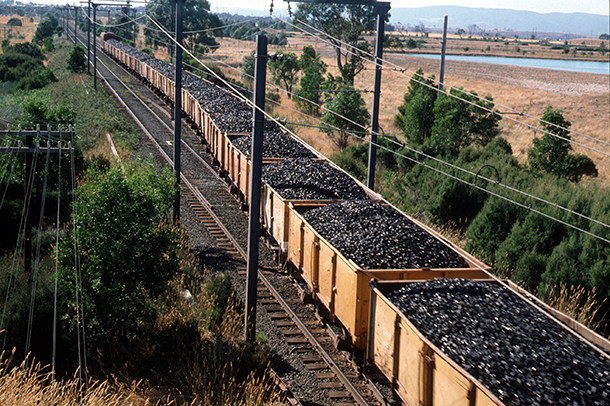
The ousting of Prime Minister Tony Abbott, whose full-steam-ahead attitude on coal undermined Australia’s climate policy, may prove a boon for the U.N. climate negotiations in Paris. (Photo: CSIRO, Wikimedia Commons CC BY 3.0)
CURWOOD: Okay, which one?
DYKSTRA: The U.S. media – specifically a new owner at National Geographic, a change in direction at the Weather Channel, and a minor insurrection at CNN. Let’s start with that one first. An industry news site, Mediaite, reported that CNN producers fired some angry questions at their boss, CNN chief Jeff Zucker, over his decision to pre-empt a network special on the 10th anniversary of Katrina in favor of – you guessed it – more coverage of Donald Trump. In Zucker’s defense, I’d say that Katrina was only a Category three hurricane and Trump, of course, is a Category 5 windbag and capable of doing a lot more damage to America. I’m just sayin’.
CURWOOD: Yes, so you are. On to the Weather Channel, please.
DYKSTRA: The Weather Channel’s owners at NBC laid off some staff last week – that’s never good news and it’s all too common in our industry. But along with that came some good news. The Weather Channel’s going back to focusing on … the weather! They’re moving away from the trend toward reality-tv shows, and back to what they’re good at.
CURWOOD: Whoa, the next thing you know, MTV’ll be going to go back to music.
DYKSTRA: Or The Learning Channel’s going to have some stuff worth learning, instead of Honey Boo Boo and pre-school beauty pageants. But on to National Geographic. The venerable magazine has turned controlling interest over to Twenty First Century Fox, one of the corporations run by Sir Rupert Murdoch and his son James. Nat Geo Media will turn from nonprofit to for-profit, and a lot of people are deeply concerned that the anti-science, anti-environment stance of some Murdoch properties, like Fox News, will show its head at National Geographic. I’m worried too, but I’m far from convinced. There are a lot of good, strong people at National Geographic magazine and the website. If they go, I fear for the place. If not, the Murdochs are smart enough business people to not mess with a respected, successful brand.

National Geographic Media is joining the same Murdoch corporation that owns Fox News. The magazine’s integrity will stick around, Dykstra predicts, as long as the Murdochs don’t pollute it with anti-environmentalism. (Photo: Raysonho, Wikimedia Commons CC0 1.0 Universal)
CURWOOD: Well, let’s hope. What have you brought us from the history vault this week?
DYKSTRA: Guess who turned 25 this week? Captain Planet, the green-haired, blue-faced eco-super-hero created by my old boss, Ted Turner.
CURWOOD: Well, a happy birthday to the Captain – that makes him seven months older than Living on Earth.
DYKSTRA: And neither LOE nor the Captain are showing signs of a mid-life crisis.
CURWOOD: Well, the mid-twenties are still a bit early for that, don’t you think?
DYKSTRA: Yes, and as for the Captain, no male superhero pattern baldness, either. He still has a stunning crop of hair so lush and green it could be the tall grass along the 15th fairway at the Augusta National Golf Club, and that adorable blue face.
CURWOOD: And the bravery in defense of the Earth.
DYKSTRA: Yes, and in the 6 years the series ran, Captain Planet and his Planeteers – kids from around the world - battled environmental villains with over-the-top names like Hoggish Greedly and Duke Nukem, and unlike what happens in real life, the environment won in the end every time. I’ve met a lot of people who grew up in the Nineties who say that Old Blueface touched their lives. Like everything, the series is still easy to find on the web, and the Captain Planet Foundation still does charitable good eco-deeds.
CURWOOD: Peter Dykstra is with Environmental Health News, that’s EHN.org, and the DailyClimate.org. Thanks, Peter, and talk to you next time.
DYKSTRA: All right, Steve, thanks a lot, talk to you soon.
Related links:
- In this week’s trip beyond the headlines, Peter Dykstra reports the ousting of Australia’s climate-denying Prime Minister—and potentially Canada’s—as well as some changes in the U.S. media that could influence pubic conversations on the environment and climate change. We also celebrate the anniversary of Captain Planet and his legacy of saving the world.
- CNN Bumped Anderson Cooper Special to Fit in More Trump Coverage
- Rupert Murdoch just bought National Geographic. Here’s the problem everybody should be talking about.
- The Captain Planet Foundation
- Video: Jimmy Fallon mocks weather channel on returning to covering weather
CURWOOD: And there’s more on these stories at our website, LOE.org.
[MUSIC: Captain Planet theme, performed by Murray McFadden&Timothy Mulhollan w/James Coburn (written by Tom Worrall/Nick Boxer/Phil Collins), licensed to DIC and Hanna-Barbera]
CURWOOD: Coming up...on the eve of the Pope’s visit to the US a conservative Protestant evangelical leader reflects on the pontiff’s climate change encyclical. That's just ahead on Living on Earth. Stay tuned.
ANNOUNCER: Funding for Living on Earth comes from United Technologies, a provider to the aerospace and building systems industries worldwide. UTC Building & Industrial Systems provides building technologies and supplies container refrigeration systems that transport and preserve food and medicine, with brands such as Otis, Carrier, Chubb, Edwards and Kidde. This is PRI, Public Radio International.
The Night Bird

Eastern Whip-poor-wills are not technically songbirds, but their calls function as a song. (Photo: Laura Gooch, Flickr CC)
CURWOOD: It’s Living on Earth, I'm Steve Curwood.
[MUSIC: BIRDNOTE® THEME]
CURWOOD: Now the shrinking of forests in the US is having noticeable effects on wildlife, and particularly birds that rely on tree cover to nest. One of them is the star of today’s BirdNote. Here’s Michael Stein.
BirdNote®
Eastern Whip-poor-will – Bird of the Night Side of the Woods
[Whip-poor-will song throughout]
In September of 1851, Henry David Thoreau wrote:
“The Whip-poor-wills now begin to sing in earnest about half an hour before sunrise, as if making haste to improve the short time that is left them.
[Whip-poor-will song]

Eastern Whip-poor-wills have brindled plumage, which camouflages them well amongst dead leaves and tree bark. (Photo: Jerry Oldenettel, Flickr CC)
…They sing for several hours in the early part of the night, then sing again just before sunrise.”
Clearly and continuously, the bird announces its name [Whip-poor-will song].
In summer to early fall, Eastern Whip-poor-wills breed in woodlands of eastern North America. Their camouflaged plumage blends seamlessly with dead leaves on the forest floor. At dawn and dusk and all through moonlit nights, whip-poor-wills sally out from tree branches to hawk flying insects.
Woodland habitat has greatly diminished for Eastern Whip-poor-wills, as forests become more fragmented. The National Audubon Society lists them among the Top 20 Common Birds in Decline. Protecting and restoring large expanses of forest are crucial for many forest species, including the whip-poor-will.
[Whip-poor-will song and crickets]
It remains, as Thoreau described: “…a bird . . . of the night side of the woods, where you may hear the whip-poor-will in your dreams.”
I'm Michael Stein.

Eastern Whip-poor-wills are part of a bird classification called nightjars. This group is known to be active during the late evening, night and early morning. (Photo: Richard Crossley, CC BY-SA 3.0)
###
Written by Frances Wood; revised by Bob Sundstrom
Bird sounds provided by The Macaulay Library of Natural Sounds at the Cornell Lab of Ornithology, Ithaca, New York. Song of the Whip-poor-will (Eastern) [84871] recorded by W.L. Hershberger. BirdNote’s theme music was composed and played by Nancy Rumbel and John Kessler.
Producer: John Kessler
Executive Producers: Chris Peterson/Dominic Black
© 2015 Tune In to Nature.org September 2015 Narrator: Michael Stein
Whip-poor-will on branch - Laura Gooch https://www.flickr.com/photos/lgooch/6991532244
Whip-poor-will on ground - Jerry Oldenettel https://www.flickr.com/photos/jroldenettel/6199157613
http://birdnote.org/show/whip-poor-will
Related links:
- Whip-poor-wills on BirdNote®
- More about Whip-poor-wills on All About Birds
- Whip-poor-wills on Audubon’s Guide to North American Birds
CURWOOD: And there are photos at our website, loe dot org.
[MUSIC: Balval, Molin Molette, Le Ciel Tout Nu, Whaling City Sound, 2013]
An Evangelical View of the Climate and Pope Francis
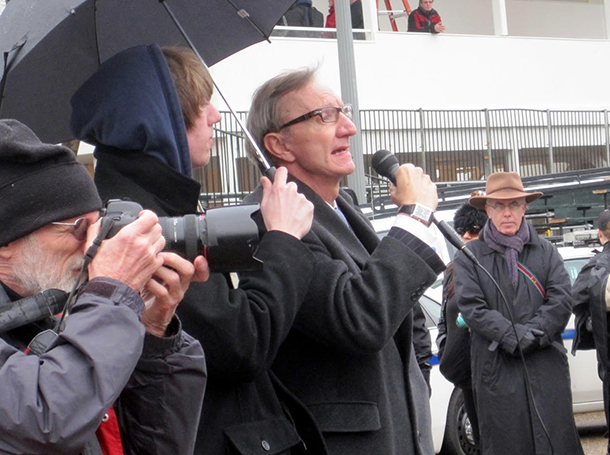
In January 2013, Rev. Cizik spoke at the Moral Action on Climate Rally in Washington, D.C. in front of the Capitol’s inaugural stands. (Photo: courtesy of Rev. Richard Cizik)
CURWOOD: Soon Pope Francis will begin his first trip to the United States, where he will address a joint session of Congress – and get an enthusiastic welcome from people of all faiths and walks of life. His defense of the poor, and his demand for action on climate change in his encyclical “Laudato Si” have made him a rock star to millions. Well, we thought we’d try and get an Evangelical Christian perspective, so we called up the Reverend Richard Cizik. For more than a decade Richard Cizik has been an outspoken advocate of “creation care,” the belief that stewardship of the Earth is a God-given responsibility. He is the former vice president of government affairs for the National Association of Evangelicals, which represents more than 45,000 churches. He’s now President of the New Evangelical Partnership for the Common Good, which seeks to end partisan and sectarian divisions. Reverend Cizik, welcome back to Living on Earth.
CIZIK: Thank you, Steve, it's my pleasure.
CURWOOD: First, what’s your reaction to Pop Francis' environmental cyclical “Laudato Si”?
CIZIK: Oh, extraordinarily excited. I think he's hit upon not only the most compelling issues of the 21st century -- climate change and its impact of that upon our Earth – but in a secondary way the whole impact of faith itself upon politics upon society, waning in the minds of some, certainly not to him. He is popular, he is influential, he is coming to America. “Laudato Si” literally translates to "Praise be to you, my Lord" and in the words of this beautiful canticle by St. Francis of Assisi, he writes in the encyclical, St. Francis reminds us that our common home is like a sister from whom we share a life and a beautiful mother who opens her arms to embrace us, and “praise be to you, our Lord and our sister and Mother Earth who sustains and governs us, and who produces various fruit with colored flowers and herbs”. This is poetic language, it's beautiful. It comes from Romans and elsewhere, and, frankly, it's good to point that out, Steve, because the Earth does groan in travail, as the apostle Paul wrote in Romans 8:22.
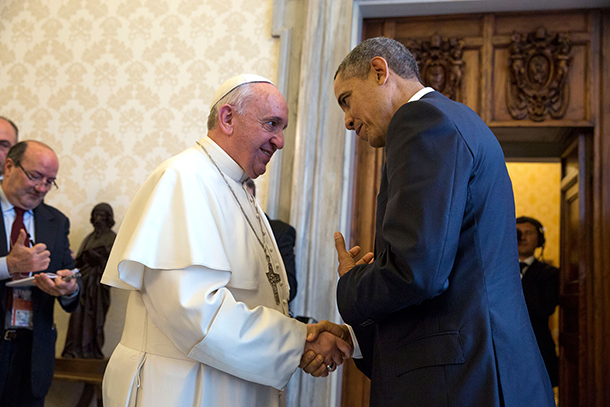
Pope Francis will meet with President Obama during his September 2015 visit to the nation’s capitol. (Photo: Gaspard Miltiade, Wikimedia CC government work)
CURWOOD: What do people both within your faith in outside of it need to do about the climate, in your view?
CIZIK: They need to begin to think differently, and that's what the Pope says too. Most of all, he's called for an ecological conversion for the faithful. That's what Evangelicals need to do. It's to begin to see what's happening to the Earth. It's described in this encyclical, it's persuasive. Man is doing this to our environment, our common home as the Pope calls it.
CURWOOD: Now you've had significant experience representing evangelicals in front of political figures. How do you see this environmental encyclical from the Pope as affecting the conversation on the Hill in Washington about climate change?
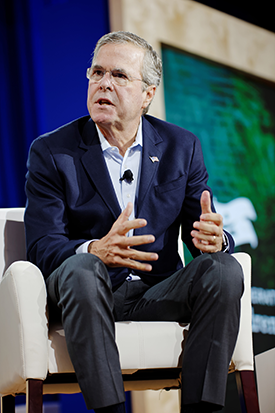
Reacting with disapproval to the environmental encyclical, Jeb Bush, a devout Catholic convert, said, “[religion] ought to be about making us better as people, less about things [that] end up getting into the political realm.” (Photo: Michael Vadon, Wikimedia CC BY-SA 4.0)
CIZIK: It's going to be, first of all, political theater of the highest sort. A pope addressing a joint session of Congress? The question is probably not whether his voice will have a political impact. It most certainly will, because he is the Pope, the Holy Father, he carries weight not just with Catholics, but even with a lot of mainstream Americans and Evangelicals. The polls show that. And so he's going most surely to touch upon issues like capitalism itself, immigration, climate change and what he very much cares about -- mainly, help for the poor, its inter-relationship to environmental protection and economic inequality. And these are all issues in our election year, believe it or not, and a lot of Republicans, well, they are the ones who have been pooh-poohing these. I would hope and pray, frankly, that he makes the most of the moment and challenges politicians who are essentially bought, Steve, this is really true. It's just legalized bribery by the oil and gas and other industries that profit. We have politicians who will be sitting in front of this moral leader who are bought and paid for by the oil and gas industries, and they should be ashamed of themselves, but they probably won't be.
CURWOOD: The field of presidential candidates is filled with folks who are members of the Christian faith. Some are evangelicals, some are Catholic. How do you think climate change might come into play as an issue as this race picks up, and how might their faith influence this conversation?
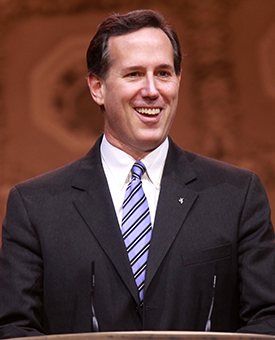
Rick Santorum, another Catholic presidential candidate, said Pope Francis should, “leave science to the scientists.” (Photo: Gage Skidmore, CC BY-SA 3.0)
CIZIK: Well, you do have Catholics as you said, such as Jeb Bush, Marco Rubio, Martin O'Malley and Chris Christie, they're all Catholics. Well, there could be a domino effect if the pope speaks out on climate change and how they respond to it. So it's going to be hard to avoid the politics of all of this. You have Evangelicals in this too, and so you'll have actually sitting in the chamber there for the big speech, Marco Rubio, Lindsey Graham, Rand Paul, Ted Cruz, these are senators. And so the question is: will they sit on their hands or will they applaud? And of course the resonance of what he says will have a huge, huge impact upon the public, and most importantly, I hope, upon the public's view of this issue. Because only about 16 percent, Steve, think that climate change will impact them personally - it's just happening somewhere else, not here. And of course we know just the opposite is true. This Pope is not going to tell people exactly what to think... he will tell them, I think, what to think about, and that's just as important.
CURWOOD: How do you respond to Jeb Bush's less than enthusiastic reaction to the Pope's encyclical?
CIZIK: Yeah, Jeb Bush's response was both derision and dismissal. He, as you know, is a Catholic convert. And so, for him to say that "Well, I don't get economic policy from my Bishops or my Cardinal or my Pope,” well, that it is minimize and to play into just the opposite of what Republicans have always said should be true, which is that faith and religion should have a voice in the public squares. And frankly, faith voices have always been the ones most importantly challenging the public to take up an issue that's not previously perceived as moral to be just that. Look at race relations, women's suffrage, and most particularly, nowadays, the environment is what faith is saying is important and is a moral agenda.
CURWOOD: How ironic is it that Rick Santorum said that the church should "leave science to the scientists"? The Pope himself was trained as a chemist.
CIZIK: Absolutely, even post-secondary education as a chemist... taught it! And so he brings a scientific expertise to this, and you can't just say what the Republicans have been saying, well, leave it to the scientists, I'm not a scientist. Well, that just doesn't work. That's just a red herring, as they call it. The Republicans are going to be put in an unusual position by a moral leader of a magnitude of none other on this planet who is calling them, as he is calling all of us, to rethink how we live in this place called our common home, Earth. And who else could do this any better? So, for those of us who have been praying about this, working on this, this is an inflection moment.
CURWOOD: Now, you're firmly within the pro-life camp, Reverend Cizik. How do you see the climate issue as pro-life?
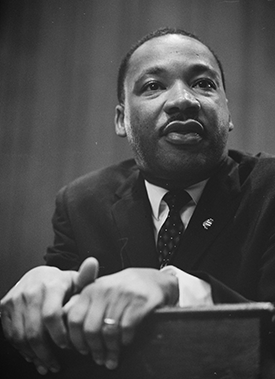
Rev. Cizik points out that faith leaders have a tradition of championing social justice causes like the civil rights movement. (Photo: Marion Trikosko, Library of Congress public domain)
CIZIK: Oh, it certainly is. God's love in creation is so evident, and that's part of the encyclical, it’s one of the chapters. And so the Holy Father, Pope Francis, after his namesake Francis, insists that every human being is an image of God and nothing or no one is superfluous. And he writes in the document that the entire material universe speaks of God's love, his boundless affection for us -- soil, mountains, water -- everything as it were a caress of God. He goes onto say the history of our friendship with God is always linked to particular places which take on an intensely personal meaning. It's just wonderful language which communicates not only God's love for us as humans, but God's love for creation. All of life is sacred and that is so uplifting. Some people think it's a gloomy document. I don't think so. I think it's beautiful, and it's poetic. It's even scientific. I remember one person who put it this way, he said, “this document is a combination of St. Augustine and the National Academy of Sciences”, and it's sort of a representation of the Pope himself, wouldn't you say?
CURWOOD: Indeed. Let's talk about the Evangelicals’ possible response here. You're among very few public evangelicals who've spoken out on climate change. To what extent do you feel that you were pressured to reign in your statements on global warming back at the time that you were at the national organization, the National Association of Evangelicals?
CIZIK: Well, you may recall, I think we talked at the time, Steve, we had put together what was called the ECI, the Evangelical Climate Initiative, and I couldn't sign it, even though I had organized with my friend the Rev. Jim Ball, of the Evangelical Environmental Network at the time, to put it together -- I couldn't put my own name on it. And then, for the next five or six years I took a lot of flak, as it were, for speaking out as I did. Ultimately it forced me to leave the association where I worked for 28 years. So there have been huge impacts for me personally, but I think for the Evangelical movement as a whole it has been a black mark on the movement that its leaders, most of it is leaders, some of whom originally signed the Evangelical Climate Initiative, were forced to take their names off too. So, the Evangelical leaders haven't taken this leadership as they should have, and I think their children, grandchildren and others will look back and ask, “what did you do, dad, or granddad. What did you do about this issue?”, and some will have to, with embarrassment, admit absolutely nothing. In fact, they denied the science.
CURWOOD: The last time we spoke, Reverend Cizik two years ago, you estimated that three-quarters of Evangelicals would be in support of addressing climate change.
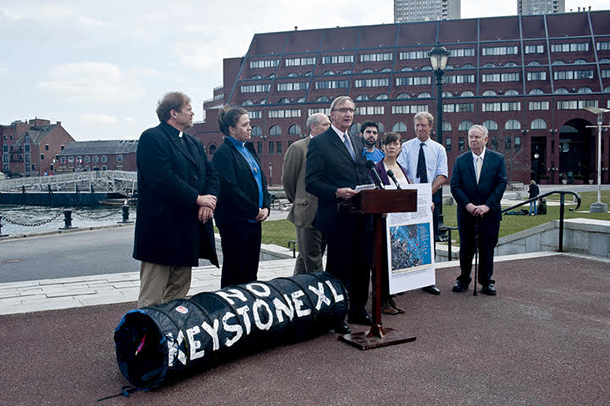
Last year, standing by the Boston Harbor, Rev. Cizik spoke out against the Keystone XL pipeline. (Photo: courtesy of Rev. Richard Cizik)
CIZIK: I think it's only when you get into some of the specifics that you get some disagreements, so yeah, it's a big split. The numbers are increasing demographically, slowly, but the Evangelicals are coming on board. A lot of them are too afraid yet to speak out, we know that. There're pastors and churches where they're afraid someone might take exception if they come out and say “I support action on climate change, it's imperative, it is a moral thing to do”. They're still afraid. Let's be optimistic here, younger Evangelicals, I call them the new Evangelicals, they get the science, they get the moral imperative, they are winning the day and they don't have a problem here, they get it.
CURWOOD: Before you go Reverend Cizik, Evangelicals typically have a conversion experience. They decide at some point that they are really going to embrace their faith, and, of course, conversion means change. How likely is it that large numbers of Evangelicals will change their position on the concern about climate?
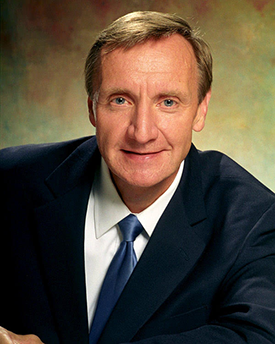
Rev. Cizik is co-founder and President of the New Evangelical Partnership for the Common Good. He formerly served as the Vice President of Government Affairs with the National Association of Evangelicals. (Photo: courtesy of Rev. Richard Cizik)
CIZIK: That's a tough question, Steve. Frankly, I think it will take a miracle of sorts, in the sense that the divisions, the polarization, is so deep. You have even within the Catholic Church you see a northeast White Catholicism that votes Republican. You have a southwest Latin or Hispanic and young church that votes very Democratic. You have that divide within the Catholic church, and you have that same kind of divide within Evangelicalism, and so it's going to take a miracle of sorts for people's hearts to be changed, because climate change has joined the religious right's cause for division over issues: same sex marriage, abortion and the like. They’ve put climate change in that equation, and that is so sad. That's why the Pope's visit is so very important, because he is so admired. He is pro-life. You see, he cares about the family and the gender issues that Evangelicals care about, so if they love him for those things they should love him for this thing too, that is on climate change, and it's going to be interesting to see how much he moves the needle, so to speak. I think he can. I think we’re at an inflection moment in time that is God-ordained, and I praise the Lord for it.
CURWOOD: Reverend Richard Cizik is President of the New Evangelical Partnership for the Common Good. Thanks so much for taking the time today.
CIZIK: Thank you.
Related links:
- Pope Francis’s Environmental Encyclical, “Laudato Si’”
- Here’s How All The Catholic Presidential Candidates Are Responding To The Pope’s Climate Encyclical
- About Richard Cizik and the New Evangelical Partnership for the Common Good
- The Evangelical Climate Initiative
- Our previous discussion with Rev. Cizik on “creation care”
- Rev. Cizik on Obama’s invoking of religious commandments to act on climate, our story
- “My Journey Toward the ‘New Evangelicalism’” by Rev. Cizik
- “Protecting Public Lands and Restoring Equal Ground” by Rev. Cizik
- “What President Obama Should Discuss with Pope Francis” by Rev. Cizik
[MUSIC: Lyndell Leatherman (Robert Lowry), Shall We Gather at the River?, published 2013 on Youtube’s “piano4Christ” channel (not commercially available)]
[SOUNDS OF BUBBLING MUD.]
CURWOOD: Imagine yourself in Yellowstone National Park as we leave you this week.
In front of you is the Fountain Paint Pot. It gets its name from the bright yellows and reds and browns of the oxidized iron in the mud that bubbles up from the caldera.
[MORE BUBBLING MUD]
CURWOOD: Walk a little further along the Lower Geyser Basin boardwalk, you’ll come across the Spasm Geyser. It’s a small geyser, and how much water it shoots up depends on the time of year. There’s less in the late summer.
[SOUNDS OF RUSHING GEYSER]
CURWOOD: John Benham recorded these sounds for his CD, Yellowstone National Park Audio Tour of Discovery.
[SOUNDS OF GEYSER AND MUD CONTINUE]
CURWOOD: Living on Earth is produced by the World Media Foundation and brought to you from the campus of the University of Massachusetts Boston, in association with its School for the Environment, developing the next generation of environmental leaders. Our crew includes Naomi Arenberg, Bobby Bascomb, Emmett Fitzgerald, Lauren Hinkel, Helen Palmer, Adelaide Chen, Jenni Doering, John Duff, and Jennifer Marquis. Tom Tiger engineered our show, with help from Jake Rego, Noel Flatt and Jeff Wade. Alison Lirish Dean composed our themes. You can find us anytime at LOE.org - and like us, please, on our Facebook page - it’s PRI’s Living on Earth. And we tweet from @LivingOnEarth. I'm Steve Curwood. Thanks for listening.
ANNOUNCER1: Funding for Living On Earth comes from the Grantham Foundation for the protection of the environment, supporting strategic communication and collaboration in solving the world’s most pressing environmental problems. The Kendeda Fund, furthering the values that contribute to a healthy planet, and Gilman Ordway for coverage of conservation and environmental change. Living on Earth is also supported by Stonyfield Farm, makers of organic yogurt, smoothies and more; www.stonyfield.com.
ANNOUNCER2: PRI. Public Radio International
Living on Earth wants to hear from you!
Living on Earth
62 Calef Highway, Suite 212
Lee, NH 03861
Telephone: 617-287-4121
E-mail: comments@loe.org
Newsletter [Click here]
Donate to Living on Earth!
Living on Earth is an independent media program and relies entirely on contributions from listeners and institutions supporting public service. Please donate now to preserve an independent environmental voice.
NewsletterLiving on Earth offers a weekly delivery of the show's rundown to your mailbox. Sign up for our newsletter today!
 Sailors For The Sea: Be the change you want to sea.
Sailors For The Sea: Be the change you want to sea.
 The Grantham Foundation for the Protection of the Environment: Committed to protecting and improving the health of the global environment.
The Grantham Foundation for the Protection of the Environment: Committed to protecting and improving the health of the global environment.
 Contribute to Living on Earth and receive, as our gift to you, an archival print of one of Mark Seth Lender's extraordinary wildlife photographs. Follow the link to see Mark's current collection of photographs.
Contribute to Living on Earth and receive, as our gift to you, an archival print of one of Mark Seth Lender's extraordinary wildlife photographs. Follow the link to see Mark's current collection of photographs.
 Buy a signed copy of Mark Seth Lender's book Smeagull the Seagull & support Living on Earth
Buy a signed copy of Mark Seth Lender's book Smeagull the Seagull & support Living on Earth

